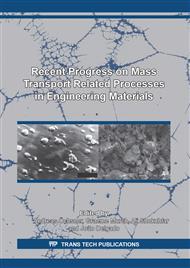p.117
p.123
p.135
p.146
p.152
p.159
p.170
p.176
p.186
Flexible Poly(imide) Siloxane Block Copolymers to Use at Biomedical Products
Abstract:
The novel research on organic polymer chemistry and physical organic chemistry involve poly(imide) siloxane on advanced and emerging technologies in radiation therapy. The poly(imide siloxane) block copolymers were synthesized at different production conditions for the use of biodegradable and biocompatible materials to use at biomedical products. These block copolymers were produced by using 4,4'-oxydianiline (ODA) and 3,3,4,4-Benzophenone-tetracarboxylic dianhydride (BTDA) to form polyimide hard block. APPS and BTDA formed the polysiloxane soft block. The polysiloxane soft blocks were increased by increasing the polyimide hard blocks. Copolymers are synthesized by adjusting the soft and hard segments. Copolymers can be obtained by holding constant hard block segments and by adjusting soft block segments. Hence, flexible poly(imide siloxane) block copolymers were derived. The samples were derived in a flexible rubber form. The prepared copolymers possess the properties of elastomers. Due to these properties, these materials have potential usage in microelectronics devices and medical devices. Poly(imide) siloxane, which can be produced with the desired form and conformed at different configurations, is important in such areas. In this research, the studies on poly(imide) siloxane have supported innovative and comprehensive radiation technology in polymer industries, experimental approaches for the innovative biomedical products. The samples were characterized as flexible rubber form and this property was detected and the creep test of poly (imide) siloxane was performed by Dynamic Mechanical Analyser (DMA).
Info:
Periodical:
Pages:
152-156
Citation:
Online since:
March 2020
Authors:
Price:
Сopyright:
© 2020 Trans Tech Publications Ltd. All Rights Reserved
Share:
Citation:


